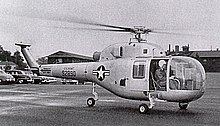| XH-39 (S-59) | |
|---|---|

| |
| Sikorsky XH-39 | |
| Role | HelicopterType of aircraft |
| Manufacturer | Sikorsky Aircraft |
| First flight | 26 August 1954 |
| Introduction | not produced |
| Primary user | United States Army |
| Number built | 3 |
| Developed from | Sikorsky S-52 |
The Sikorsky XH-39 (manufacturer designation S-59), developed by Sikorsky Aircraft in 1954, was the U.S. Army's first turbine-powered helicopter. It was fast and innovative, but ultimately rejected by the United States Army in favor of the Bell UH-1 Iroquois.
Design and development

The four-seat XH-39 was powered by one Continental CAE XT51-T-3 400 shp (298 kW) turboshaft engine, a license-built development of the Turbomeca Artouste. It was developed from a previous Sikorsky model, the H-18 (company model S-52), and had the same layout. It differed in using retractable landing gear, modified tail rotor, and four-blade main rotor. In the end, the U.S. Army selected the Bell XH-40, prototype of the UH-1 Huey. Two YH-18As were modified into XH-39s; one for flight testing and the other for static test.
On 26 August 1954, the XH-39 set a world helicopter speed record of 156.005 mph (251 km/h) over a three kilometer closed course at Bradley Field (now Bradley International Airport) in Windsor Locks, Connecticut. The same year, on October 17, 1954, it set an unofficial world helicopter altitude record of 24,500 ft (7,474 m) at Bridgeport, Connecticut.
In addition to the two XH-39s, one S-59, serial number 52004, registration number N74150, was produced for use for company demonstration flights. It has been restored and is now on display at the New England Air Museum, Windsor Locks, Connecticut.
Variants

- XH-39
- Former YH-18A modified for static testing, not flown and later modified back to YH-18A standard.
- XH-39A
- Former YH-18A modified for flight testing.
Specifications (XH-39)

Data from U.S. Army Aircraft Since 1947
General characteristics
- Crew: One
- Capacity: 3 passengers
- Length: 41 ft 0 in (12.50 m)
- Height: 9 ft 7 in (2.92 m) (to top of rotor head)
- Empty weight: 2,105 lb (955 kg)
- Gross weight: 3,361 lb (1,525 kg)
- Powerplant: 1 × Continental CAE XT51-T-3 turboshaft, 400 shp (300 kW)
- Main rotor diameter: 35 ft 0 in (10.67 m)
- Main rotor area: 962 sq ft (89.4 m)
Performance
- Maximum speed: 156 mph (251 km/h, 136 kn)
- Cruise speed: 138 mph (222 km/h, 120 kn)
- Range: 280 mi (450 km, 240 nmi)
- Service ceiling: 17,900 ft (5,500 m)
See also
Related development
Aircraft of comparable role, configuration, and era
Related lists
References
Notes
- Polmar and Kennedy 1981, p. 288.
- ^ "Sikorsky Archives | S-59".
- Hearst Magazines (February 1955). "Sets Helicopter Record". Popular Mechanics. Hearst Magazines. p. 113.
- "New England Air Museum".
- Harding 1990, p. 233.
Bibliography
- Harding, Stephen. U.S. Army Aircraft Since 1947. Shrewsbury, England: Airlife, 1990. ISBN 1-85310-102-8.
- Polmar, Norman and Floyd D. Kennedy, Jr. Military Helicopters of the World: Military Rotary-wing Aircraft Since 1917.. Annapolis, Maryland: Naval Institute Press, 1981. ISBN 0-87021-383-0.
External links
- "Sikorsky Model XH-39 (S-59)." at Global Security (accessed 12 May 2008)
| Sikorsky aircraft | |
|---|---|
| Fixed-wing aircraft (company designations) | |
| Fixed-wing aircraft (military designations) | |
| Helicopters (company designations) | |
| Helicopters (military designations) | |
| Experimental aircraft | |
| United States helicopter designations, Army/Air Force and Tri-Service systems | |||||||||
|---|---|---|---|---|---|---|---|---|---|
| Numerical sequence used by USAAC/USAAF/USAF 1941–present; U.S. Army 1948–1956 and 1962–present; U.S. Navy 1962–present | |||||||||
| Army/Air Force sequence (1941–1962) |
| ||||||||
| Tri-Service sequence (1962–present) |
| ||||||||
| Not assigned | |||||||||